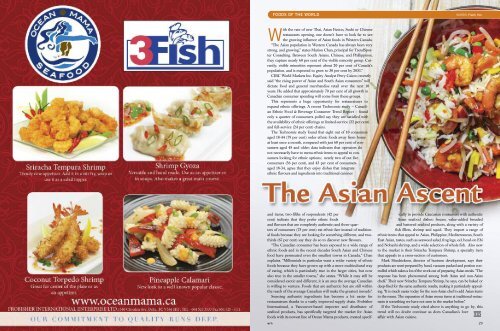WRN WINTER 2015 (WEB)
WRN WINTER 2015 (WEB)
WRN WINTER 2015 (WEB)
You also want an ePaper? Increase the reach of your titles
YUMPU automatically turns print PDFs into web optimized ePapers that Google loves.
FOODS OF THE WORLD<br />
WORDS: Frank Yeo<br />
With the rate of new Thai, Asian Fusion, Sushi or Chinese<br />
restaurants opening, one doesn’t have to look far to see<br />
the growing influence of Asian foods in Western Canada.<br />
“The Asian population in Western Canada has always been very<br />
strong, and growing,” states Marion Chan, principal for TrendSpotter<br />
Consulting. Between South Asians, Chinese, and Phillippinos,<br />
they capture nearly 60 per cent of the visible minority group. Currently,<br />
visible minorities represent about 20 per cent of Canada’s<br />
population, and is expected to grow to 30 per cent by 2031.”<br />
CIBC World Markets Inc. Equity Analyst Perry Caicco recently<br />
said “the rising power of Asian and South Asian consumers” will<br />
dictate food and general merchandise retail over the next 10<br />
years. He added that approximately 70 per cent of all growth in<br />
Canadian consumer spending will come from these groups.<br />
This represents a huge opportunity for restaurateurs to<br />
expand ethnic offerings. A recent Technomic study — Canadian<br />
Ethnic Food & Beverage Consumer Trend Report — found<br />
only a quarter of consumers polled say they are satisfied with<br />
the availability of ethnic offerings at limited-service (22 per cent)<br />
and full-service (24 per cent) chains.<br />
The Technomic study found that eight out of 10 consumers<br />
aged 18-44 (79 per cent) order ethnic foods away from home<br />
at least once a month, compared with just 60 per cent of consumers<br />
aged 45 and older; data indicates that operators do<br />
not necessarily have to menu ethnic items to appeal to consumers<br />
looking for ethnic options; nearly two of out five<br />
consumers (36 per cent), and 43 per cent of consumers<br />
aged 18-34, agree that they enjoy dishes that integrate<br />
ethnic flavours and ingredients into traditional cuisines<br />
and items; two-fifths of respondents (42 per<br />
cent) indicate that they prefer ethnic foods<br />
and flavours that are completely authentic; and three-quarters<br />
of consumers (75 per cent) eat ethnic fare instead of traditional<br />
foods because they are looking for something different, and twothirds<br />
(67 per cent) say they do so to discover new flavours.<br />
“The Canadian consumer has been exposed to a wide range of<br />
ethnic foods and in the recent decades South Asian and Chinese<br />
food have permeated even the smallest towns in Canada,” Chan<br />
explains. “Millennials in particular want a wider variety of ethnic<br />
foods because they have grown up with a more multicultural way<br />
of eating, which is particularly true in the larger cities, but now<br />
also true in the smaller towns,” she states. “While it may still be<br />
considered exotic and different, it is an area the average Canadian<br />
is willing to venture. Foods that are authentic but are still within<br />
the reach of the average Canadian will make the greatest inroads”.<br />
Sourcing authentic ingredients has become a lot easier for<br />
restaurateurs thanks to a vastly improved supply chain. Frobisher<br />
International, a Vancouver-based importer and distributor of<br />
seafood products, has specifically targeted the market for Asian<br />
foods with its newest line of Ocean Mama products, created specifically<br />
to provide Caucasian consumers with authentic<br />
Asian seafood dishes: frozen, value-added breaded<br />
and battered seafood products, along with a variety of<br />
fish fillets, shrimp and squid. They import a range of<br />
ethnic items that appeal to Asian, Philippine, Mediterranean, South<br />
East Asian, tastes, such as seaweed salad, frog legs, eel, head-on Ebi<br />
and Nobashi shrimp, and a wide selection of whole fish. Also new<br />
to the market is their Sriracha Tempura Shrimp, a specialty item<br />
that appeals to a cross-section of customers.<br />
Mark Hendrickson, director of business development, says their<br />
products are semi-prepared by hand, vacuum packed and portion controlled<br />
which takes a lot of the work out of preparing Asian meals. “The<br />
response has been phenomenal among both Asian and non-Asian<br />
chefs.” Their new Sriracha Tempura Shrimp, he says, can be baked or<br />
deep-fried for the same authentic results, making it particularly appealing.<br />
“It is much easier today for the non-Asian chef to add Asian items<br />
to the menu. The expansion of Asian menu items at traditional restaurants<br />
is something we have not seen in the market before.”<br />
If the Technomic study cited above is anything to go by, this<br />
trend will no doubt continue as does Canadian’s love<br />
<strong>WRN</strong><br />
affair with Asian cuisine.<br />
wrn 29


